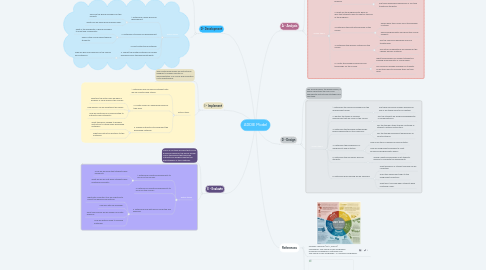
1. A - Analysis
1.1. The analysis phase is the first in the ADDIE model for development. Within this phase, goals, the audience, and resources are determined
1.2. Action Items
1.2.1. 1. Determine the target audience for the program.
1.2.1.1. What existing knowledge do students have?
1.2.1.2. Are these working professionals or full-time traditional students?
1.2.2. 2. What are the programmatic goals or skills that students need to meet by the end of the program?
1.2.3. 3. Determine the instructional goals of the course.
1.2.3.1. Where does this course fall in the program of study?
1.2.3.2. Which programmatic skills does this course support?
1.2.4. 4. Determine the delivery method for the course.
1.2.4.1. Will the course be delivered online of traditionally?
1.2.4.2. Will extra considerations be needed for the chosen delivery method?
1.2.5. 5. Locate the available resources and technology for the course.
1.2.5.1. What technologies can support students in building programmatic or course skills?
1.2.5.2. Are resources already available for students or will they need to purchase them on their own?
2. D - Design
2.1. The second phase, the design phase, is where objectives are forms and appropriate instructional strategies are identified.
2.2. Action Items
2.2.1. 1. Determine the resource available for the development phase.
2.2.1.1. Are there resources already available for use or will these need to be created?
2.2.2. 2. Identify the types of learning experiences that will occur in the course.
2.2.2.1. Will the students be working independently or collaboratively?
2.2.3. 3. Determine the teaching methodology being implemented in the classroom.
2.2.3.1. Will the teacher utilize teacher-centered or student-centered instruction?
2.2.3.2. Will the teacher implement behaviorism or constructivism?
2.2.4. 4. Determine the progression of assignments and activities.
2.2.4.1. How much time is needed for each activity?
2.2.4.2. How will assignments progress to meet course and programmatic goals?
2.2.5. 5. Determine the necessary skills for students.
2.2.5.1. Which cognitive processes must students employ to complete the assignment?
2.2.6. 6. Determine how learning will be assessed.
2.2.6.1. What evidence of student learning can be collected?
2.2.6.2. Does this assessment align to the assignment objective?
2.2.6.3. What will it look like when students have mastered a skill?
3. D- Development
3.1. The third phase, development, occurs when the plans from the design phase are actually developed.
3.2. Action Items
3.2.1. 1. Determine a work group for development.
3.2.1.1. Who are the group members for this project?
3.2.1.2. What role will each group member play?
3.2.2. 2. Determine a timeline for development.
3.2.2.1. What is the availability of group members to meet and collaborate?
3.2.2.2. When is the course being taken by students?
3.2.3. 3. Draft instructional materials.
3.2.4. 4. Submit the drafted materials for review and approval by the appropriate party.
3.2.4.1. Who will give final approval of the course and materials?
4. I - Implement
4.1. This fourth phase allows an instructional designer to prepare faculty for implementation of a course and evaluation of its effectiveness.
4.2. Action Items
4.2.1. 1. Determine how course and student data will be collected and stored .
4.2.2. 2. Create a plan for addressing issues as they arise.
4.2.2.1. What will the action plan be when a problem or issue arises in the course?
4.2.2.2. How quickly can an adjustment be made?
4.2.2.3. How will solutions be communicated to instructors and students?
4.2.3. 3. Prepare instructors to implement the developed materials.
4.2.3.1. What training is needed to prepare instructors to utilize newly developed materials?
4.2.3.2. What are instructor reactions to the materials?
5. E - Evaluate
5.1. This is a continual process that occurs during all phases of the ADDIE model. This is the phased that allows an instructional designer identify the effectiveness of their materials.
5.2. Action Items
5.2.1. 1. Determine formative assessments to occur for the course.
5.2.1.1. How will we know that students have learned it?
5.2.1.2. What will be do next when students have mastered concepts?
5.2.2. 2. Determine summative assessments to occur for the course?
5.2.3. 3. Determine how data will be collected and analyzed.
5.2.3.1. What data collection tool are effective to collect the desired information?
5.2.3.2. How will data be analyzed?
5.2.3.3. What conclusions will be drawn from data analysis?
5.2.3.4. How will data be used to improve materials?

